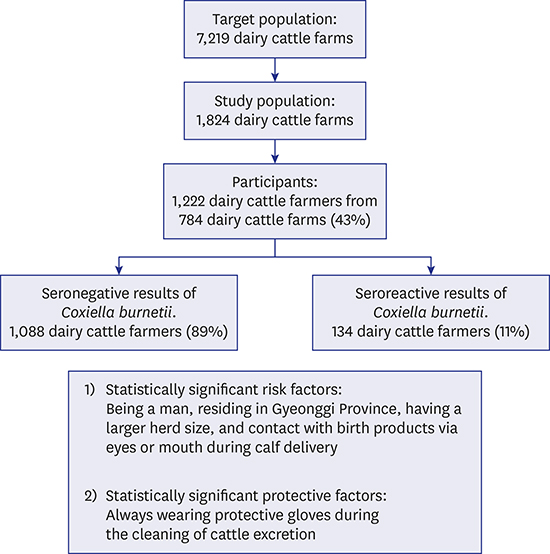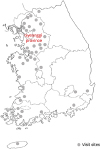1. Rodolakis A. Q fever in dairy animals. Ann N Y Acad Sci. 2009; 1166(1):90–93.

2. Guatteo R, Seegers H, Taurel AF, Joly A, Beaudeau F. Prevalence of Coxiella burnetii infection in domestic ruminants: a critical review. Vet Microbiol. 2011; 149(1-2):1–16.
3. Parker NR, Barralet JH, Bell AM. Q fever. Lancet. 2006; 367(9511):679–688.

4. Roest HI, Bossers A, van Zijderveld FG, Rebel JM. Clinical microbiology of Coxiella burnetii and relevant aspects for the diagnosis and control of the zoonotic disease Q fever. Vet Q. 2013; 33(3):148–160.
5. Maurin M, Raoult D. Q fever. Clin Microbiol Rev. 1999; 12(4):518–553.

6. Eldin C, Mélenotte C, Mediannikov O, Ghigo E, Million M, Edouard S, et al. From Q fever to Coxiella burnetii infection: a paradigm change. Clin Microbiol Rev. 2017; 30(1):115–190.
7. Schneeberger PM, Wintenberger C, van der Hoek W, Stahl JP. Q fever in the Netherlands - 2007-2010: what we learned from the largest outbreak ever. Med Mal Infect. 2014; 44(8):339–353.

8. Kwak W, Chu H, Hwang S, Park JH, Hwang KJ, Gwack J, et al. Epidemiological characteristics of serologically confirmed Q fever cases in South Korea, 2006–2011. Osong Public Health Res Perspect. 2013; 4(1):34–38.

9. Chu H, Yoo SJ, Hwang KJ, Lim HS, Lee K, Park MY. Seroreactivity to Q fever among slaughterhouse workers in South Korea. J Prev Med Public Health. 2017; 50(3):195–200.
11. Kim WJ, Hahn TW, Kim DY, Lee MG, Jung KS, Ogawa M, et al. Seroprevalence of Coxiella burnetii infection in dairy cattle and non-symptomatic people for routine health screening in Korea. J Korean Med Sci. 2006; 21(5):823–826.
12. Schimmer B, Schotten N, van Engelen E, Hautvast JL, Schneeberger PM, van Duijnhoven YT.
Coxiella burnetii seroprevalence and risk for humans on dairy cattle farms, the Netherlands, 2010-2011. Emerg Infect Dis. 2014; 20(3):417–425.

13. Bosnjak E, Hvass AM, Villumsen S, Nielsen H. Emerging evidence for Q fever in humans in Denmark: role of contact with dairy cattle. Clin Microbiol Infect. 2010; 16(8):1285–1288.

14. Sun WW, Cong W, Li MH, Wang CF, Shan XF, Qian AD. Coxiella burnetii seroprevalence and risk factors in cattle farmers and farm residents in three Northeastern Provinces and inner mongolia autonomous region, China. BioMed Res Int. 2016; 2016:7059196.
15. Agerholm JS.
Coxiella burnetii associated reproductive disorders in domestic animals--a critical review. Acta Vet Scand. 2013; 55(1):13.

16. Garcia-Ispierto I, López-Helguera I, Tutusaus J, Serrano B, Monleón E, Badiola JJ, et al.
Coxiella burnetii shedding during the peripartum period and subsequent fertility in dairy cattle. Reprod Domest Anim. 2013; 48(3):441–446.
17. Freick M, Enbergs H, Walraph J, Diller R, Weber J, Konrath A.
Coxiella burnetii: serological reactions and bacterial shedding in primiparous dairy cows in an endemically infected herd-impact on milk yield and fertility. Reprod Domest Anim. 2017; 52(1):160–169.
18. Anderson A, Bijlmer H, Fournier PE, Graves S, Hartzell J, Kersh GJ, et al. Diagnosis and management of Q fever--United States, 2013: recommendations from CDC and the Q Fever Working Group. MMWR Recomm Rep. 2013; 62(RR-03):1–30.
19. Gale P, Kelly L, Mearns R, Duggan J, Snary EL. Q fever through consumption of unpasteurised milk and milk products - a risk profile and exposure assessment. J Appl Microbiol. 2015; 118(5):1083–1095.

20. Lyoo KS, Kim D, Jang HG, Lee SJ, Park MY, Hahn TW. Prevalence of antibodies against Coxiella burnetii in Korean native cattle, dairy cattle, and dogs in South Korea. Vector Borne Zoonotic Dis. 2017; 17(3):213–216.
21. Paul S, Agger JF, Markussen B, Christoffersen AB, Agerholm JS. Factors associated with Coxiella burnetii antibody positivity in Danish dairy cows. Prev Vet Med. 2012; 107(1-2):57–64.









 PDF
PDF Citation
Citation Print
Print






 XML Download
XML Download